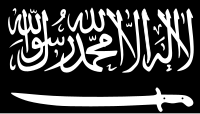| Vilayat Iriston Russian: Вилайят Иристон Ossetian: Уылайад Ирыстон / Уилайадæ Иристон | |
|---|---|
 | |
| Leaders | Alan Digorsky (Emir Saad) |
| Dates of operation | 16 May 2005[1] – 9 March 2006[2] (As Ossetian Sector of the Caucasian Front) 9 March 2006 – 7 October 2007 (As Kataib al-Khoul) 7 October 2007 – 12 May 2009 (As Vilayat Iriston) |
| Part of |
|
| Allies | |
| Opponents |
|
| Battles and wars | Second Chechen War, Insurgency in the North Caucasus |
Kataib al-Khoul (Russian and Ossetian: Катаиб аль-Хоул, romanized: Kataib al'-Khoul), also known as the Ossetian Jamaat (Russian: Осетинский джамаат, romanized: Ossetinskiy dzhamaat; Ossetian: Ирон дзамат, romanized: Iron dzamat) and Vilayat Iriston (Russian: Вилайят Иристон, romanized: Vilayyat Iriston; Iron Ossetian: Уылайад Ирыстон, Wylajad Iryston; Digor Ossetian: Уилайадæ Иристон, Wilajadæ Iriston), was a militant Islamist organization connected to numerous attacks against the local and federal security forces in the Russian region of North Ossetia–Alania in the North Caucasus. It was part of the Caucasian Front of the Second Chechen War. Its existence inside a republic which is largely Russian Orthodox had led to denial by officials who refused to recognise that an Islamic insurgency group existed in Ossetia, and instead blamed the attacks on the Ingush Jamaat.[3]
The Ossetian Jamaat, closely associated with the separatist conflict in nearby Chechnya, was established by Alan Digorsky, better known as Emir Saad. Its existence was first mentioned in May 2005 when Abdul-Halim Sadulayev created the Caucasian Front, Sadulayev referred to it as the Ossetian Sector of the Caucasian Front. Later after increased insurgency in parts of North-Ossetia, the group started to be referred to as Kataib al-Khoul. The group announced that it fought in favor of Chechnya's independence and was integrated into the Caucasian Front by the decree of the then President of Ichkeria, Sheikh Abdul Halim. Since the proclamation of the Caucasus Emirate in 2007, Kataib al-Khoul had similar goals to other Islamic nationalist insurgent groups in the region, as it sought to end Russian control of North Ossetia and establish an Ossetian Emirate of Iriston (Russian: Эмират Иристон, romanized: Emirat Iriston; Iron Ossetian: Эмират Ирыстон, Emirat Iryston; Digor Ossetian: Эмират Иристон, Emirat Iriston) with its capital at Vladikavkaz, which would be renamed as Jihadkau (Russian: Джихадкау, romanized: Dzhikhadkau; Iron Ossetian: Джихадхъæу, Dzhikhadqæw; Digor Ossetian: Джихадгъæу, Dzhikhadghæw) which in Ossetian literally translates to "City of Jihad". Despite being a group exclusively operating against Russian forces in North Ossetia–Alania, in March of 2008 in a statement claiming responsibility for the killing of the head of the Organized Crime Control Department for North Ossetia, Mark Metsaev the group claimed that it was "conducting a detailed analysis of the situation and planning operations" in South Ossetia, however this came to be nothing.[4]
Despite being a group that had claimed many attacks within North Ossetia targeting Russian forces, on 12 May 2009, Emir of the Caucasus Emirate Dokka Umarov issued a communique subsuming the rebel structures active in North Ossetia into the Emirate's Vilayat Galgayche subdivision.[5] While Dokka Umarov did not give his reasons for this decision, some speculate that the reason was that since the assassination of the mayor of Vladikavkaz, Vitaly Karayev the activities of the Vilayat came to nothing for several months. This likely served as the ground for Dokka Umarov to disband the Vilayat.[6]
- ^ https://www.kavkazcentre.com/russ/content/2005/05/16/33965/ukazom-prezidenta-chri-sadulaeva-sozdan-kavkazskij-front.shtml
- ^ https://www.kavkazcentre.com/russ/content/2006/03/09/42719/vo-vladikavkaze-atakovana-baza-rossijskikh-vojsk.shtml
- ^ "Programs - The Jamestown Foundation". Archived from the original on 21 March 2006. Retrieved 4 December 2014.
- ^ https://www.kavkazcentre.com/russ/content/2008/03/08/56868/kataib-al-khoul-my-unichtozhili-sadista.shtml
- ^ Casey Britton. "New decrees of Dokka Umarov on formation of a Council of the Caucasus Emirate and abolition of the Province of Iriston - Caucasus - News : WorldAnalysis.net". Archived from the original on 20 December 2014. Retrieved 4 December 2014.
- ^ "Archived copy" (PDF). Archived (PDF) from the original on 2022-10-14. Retrieved 2023-03-15.
{{cite web}}: CS1 maint: archived copy as title (link)